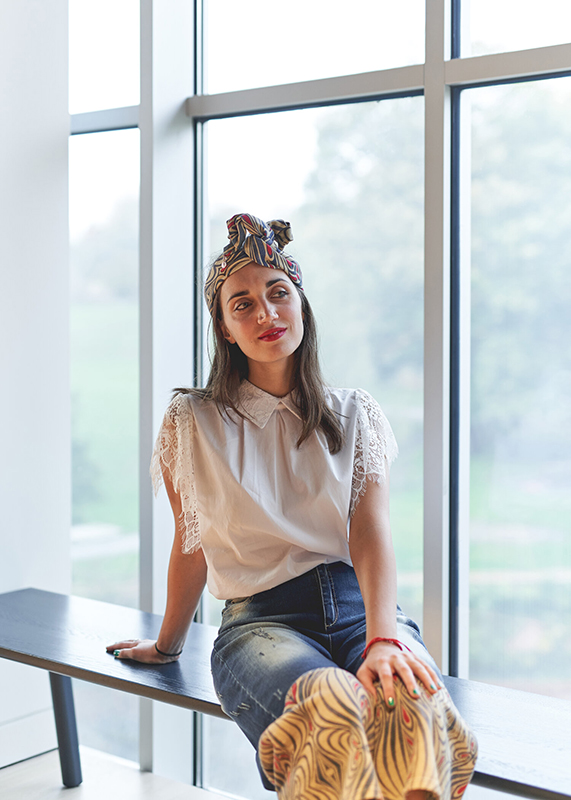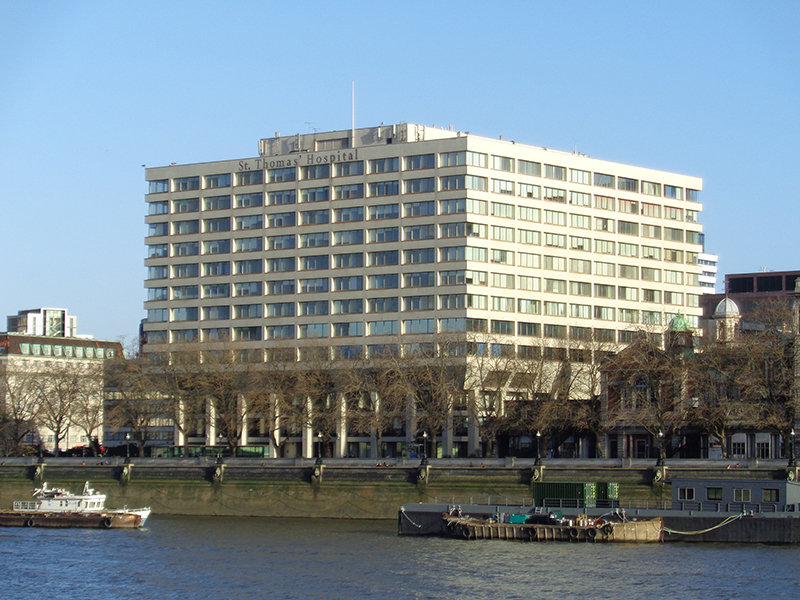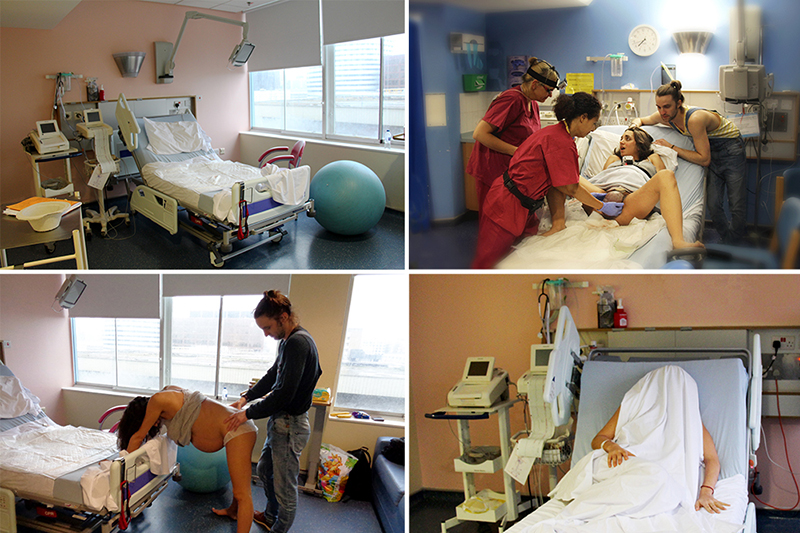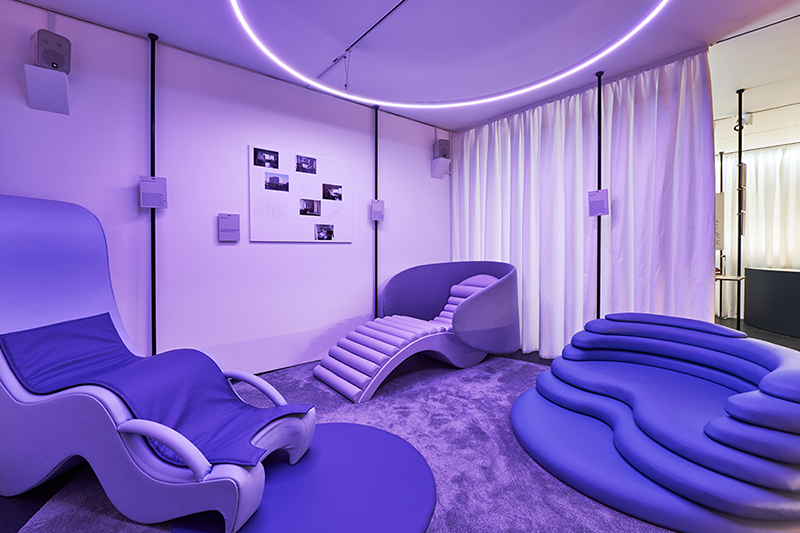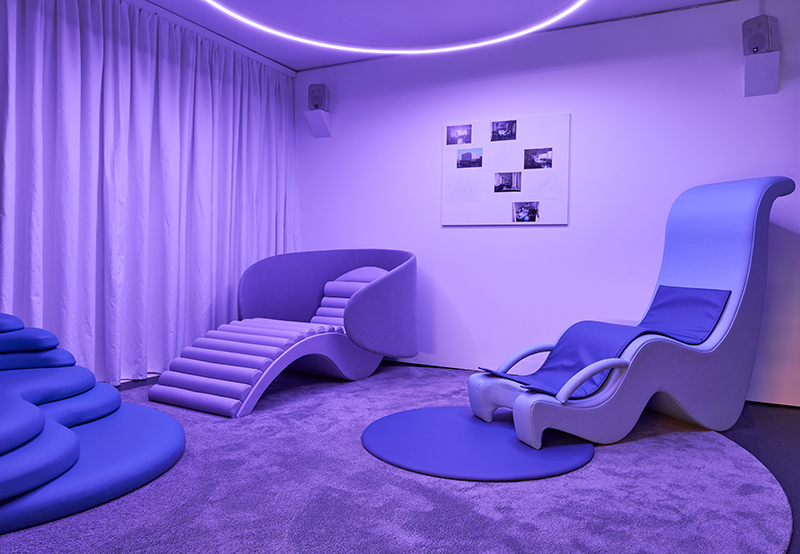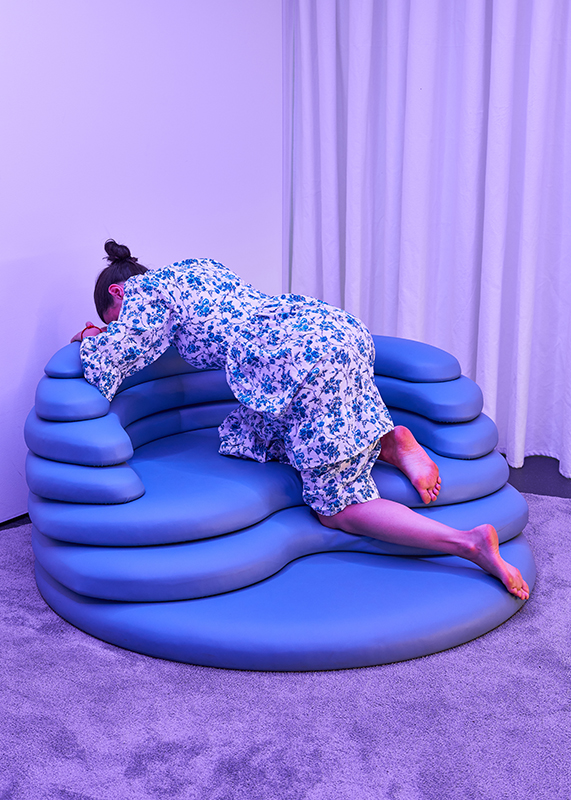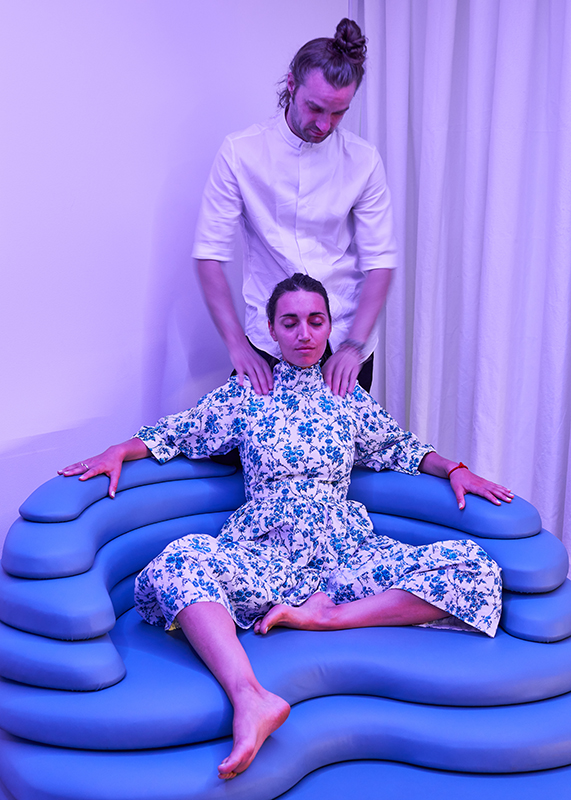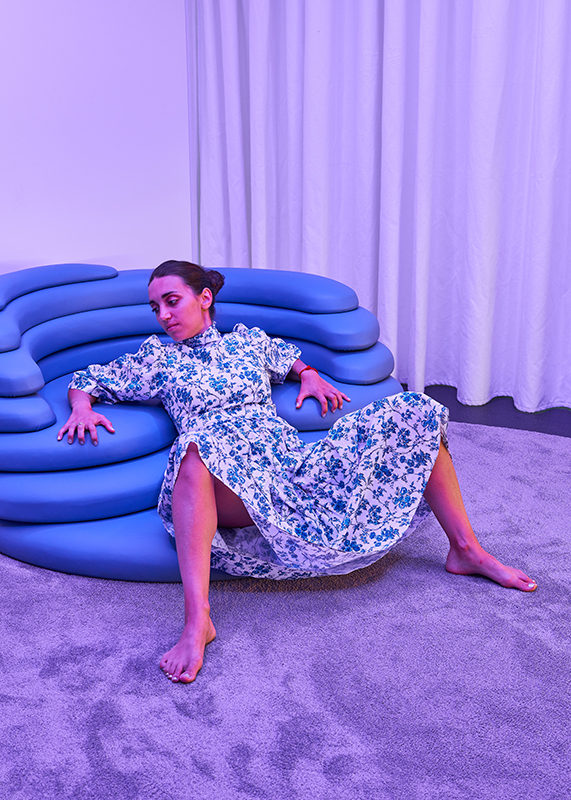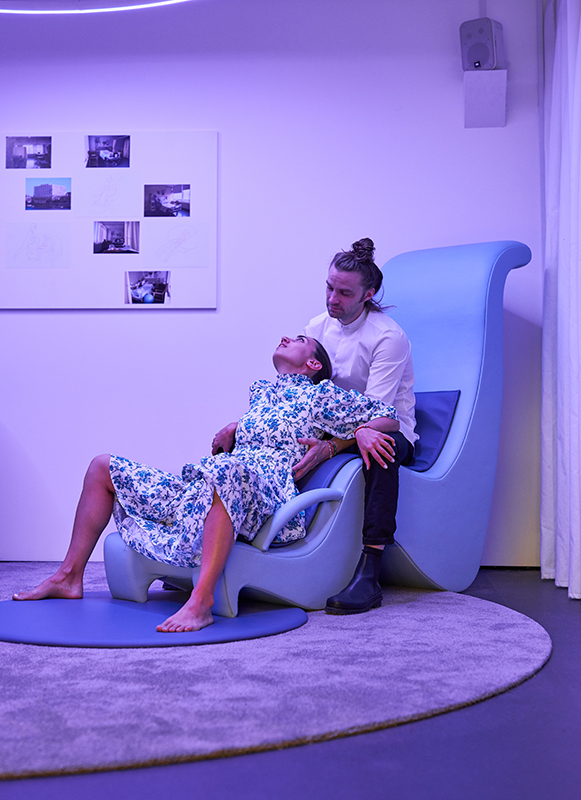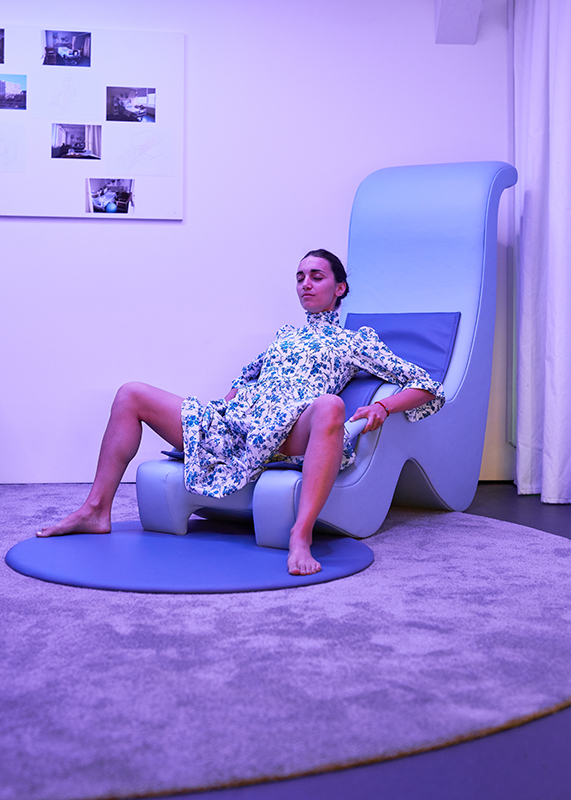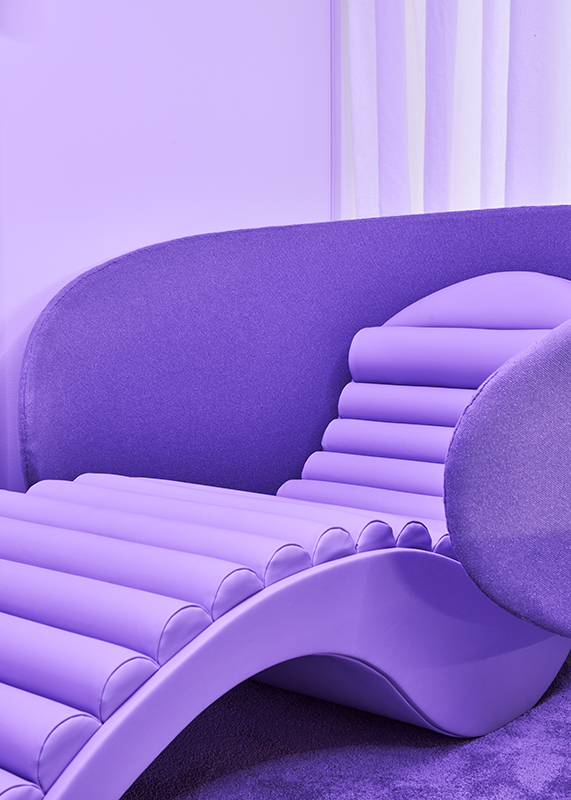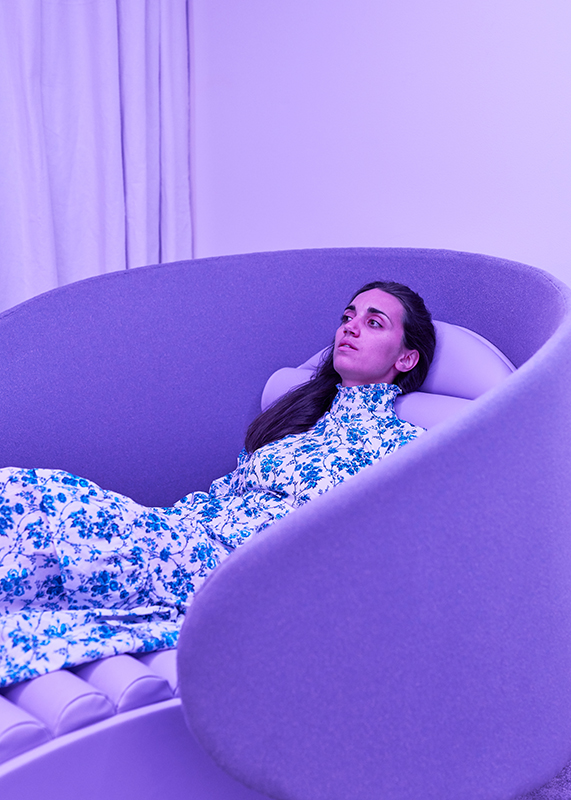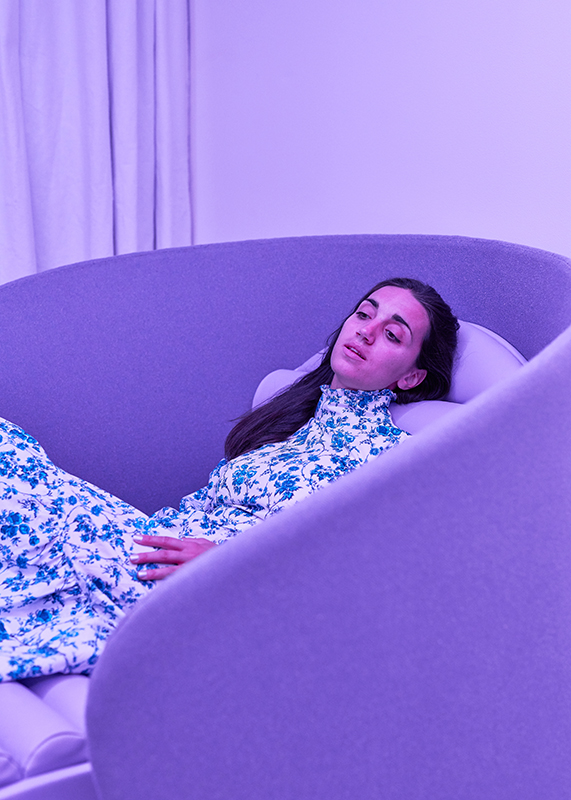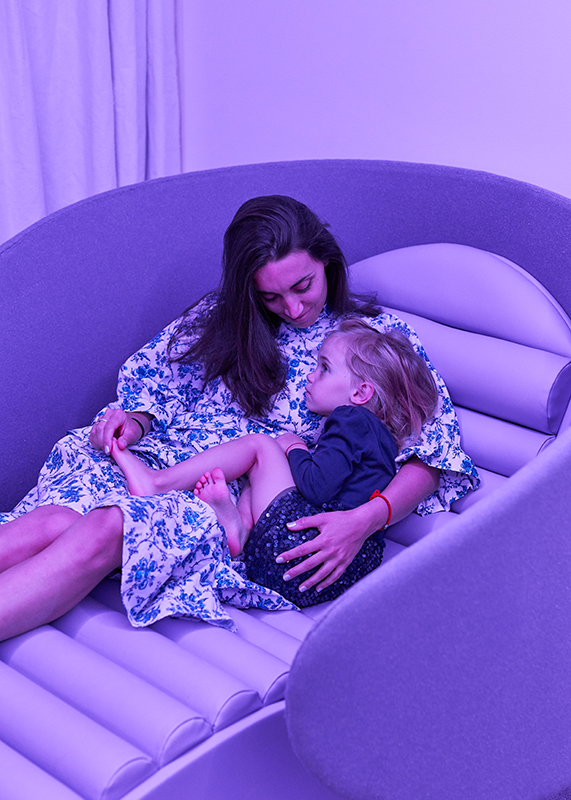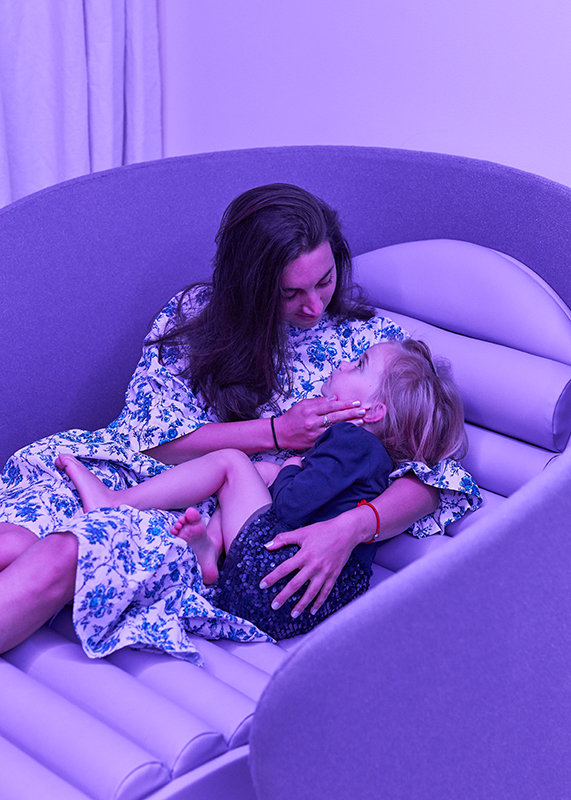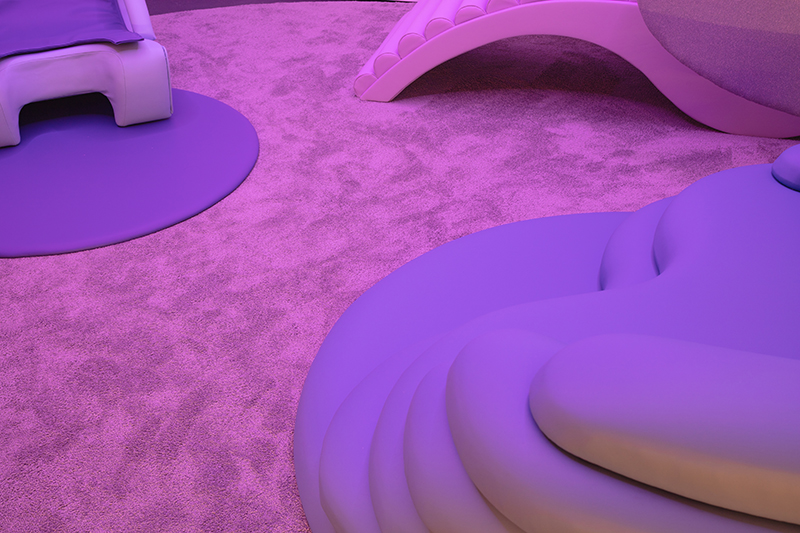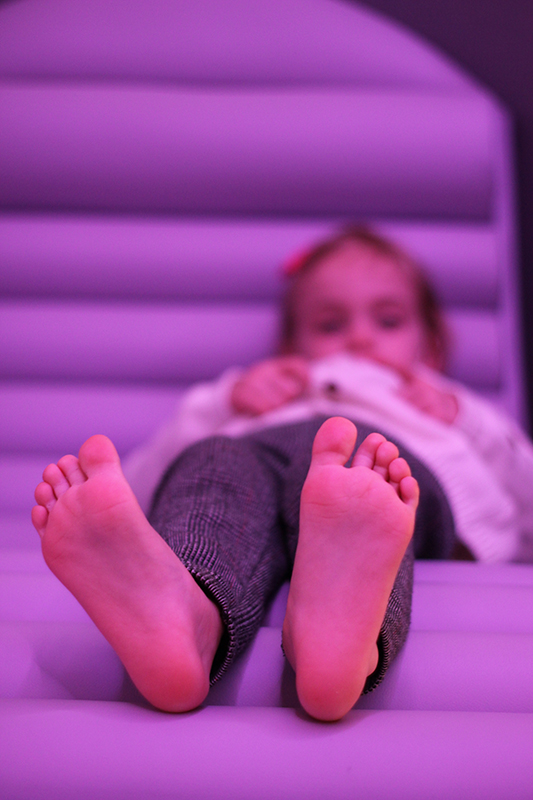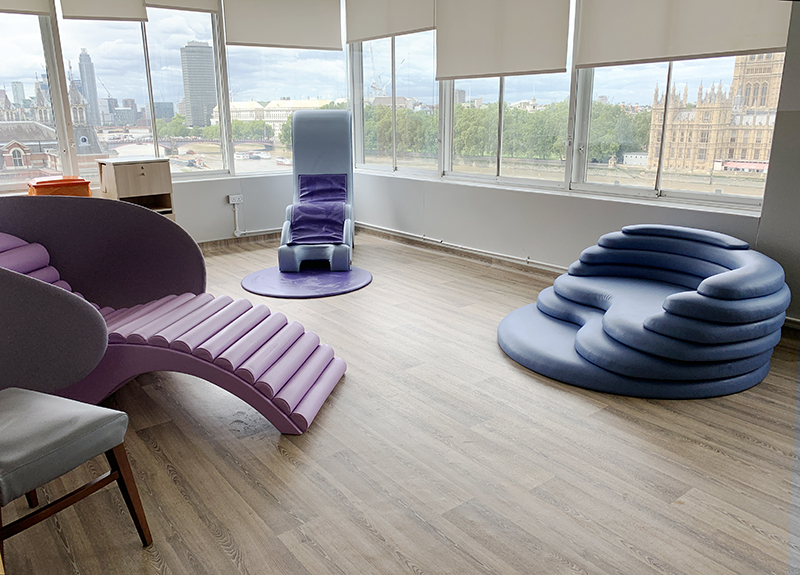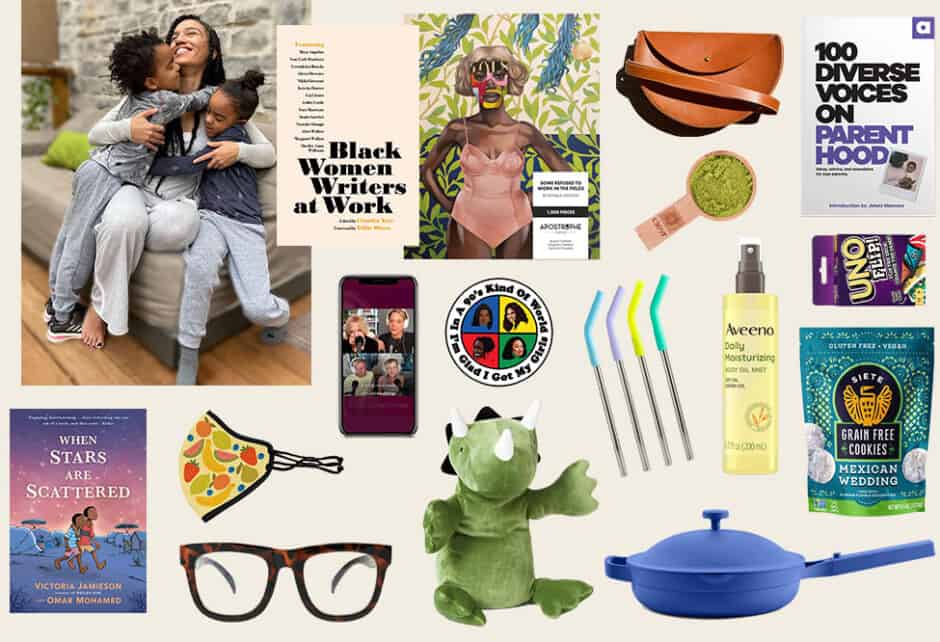
A Cosmic Labor & Delivery Design You Need To See To Believe
Written by Katie Hintz-Zambrano
Photography by Stiliyana Minkovska
For Bulgaria-born, UK-based artist and designer Stiliyana Minkovska, the birth of her daughter three years ago was an awakening in more ways than one. As any birthing person can attest to, the process itself is hard to forget. For Stiliyana, it was also a creative reawakening, as she immediately saw the need for a more female-centered birthing experience. “During Stelena’s birth, I felt at the disposal of the hospital, I felt institutionalized, like a medical object,” she explains. “I knew this was not right and as a designer I had certain creative powers to change this. It changed me as a designer and it changed me as a person, it’s been something like being reborn.”
Just three years later, Stiliyana had a second “baby,” this time, a design project she dubs Ultima Thule—a stunning, sanctuary-like environment for birth, made up of three innovative, supportive, and flexible structures. While this month marked the end of Ultima Thule‘s display at London’s Design Museum (it’s since moved on to St. Thomas’ hospital, where Stiliyana gave birth!), we’ve got the whole story—and awe-inspiring photos—of the project right here.
- "I am a qualified architect, originally from Sofia in Bulgaria. I moved to the UK in 2009 to commence my architectural education and lived and studied in Oxford for three years. I moved to London in 2012 and since then I haven't left the city, which I adore for its cultural, diverse, and cosmopolitan merits. I joined the Royal College of Art (RCA), where I was getting my masters in architecture, but halfway through the course I unexpectedly got pregnant. My entire project ended up focusing on pregnancy and childbirth; I even filmed the birth of my daughter at the St. Thomas' hospital from four different screens, which was later shown in an exhibition at the RCA." "Ever since my pregnancy and childbirth experience, I have critically engaged with the healthcare sector and more specifically with the maternity ward, where people experience one of their most profound and life-changing events. I believe my own experience urged me to think about these spaces differently and offer my expertise in changing them for the better, to be more mother-centric, working around the well-being and comfort of the birthing person, rather than working around the convenience of the hospital personnel."
- "I gave birth at the world’s most beautiful hospital, St. Thomas', overlooking the major landmarks of London—the London Eye, the House of Parliament, and Big Ben tower. It was an epic spectacle and I will never forget the whole experience. My daughter Stelena was two weeks late. We continuously laugh about how she was literally born a year later since my due date was on December 20, 2015, but she appeared on January 3, 2016. Once she was born, we were moved to the postnatal ward and my bed was right next to Big Ben’s clock. I stayed up all night looking out at the scenery and embracing this gorgeous new life that appeared from my body. It was the most transformative experience I have felt or been through in my entire life."
- "While in the hospital, I felt like a medical object. There was something standing between the way my instincts were going and what I was told to do. It felt alien and otherworldly, hence the idea to create a cosmic birth center as part of my thesis project. I designed a planetarium-like childbirth facility which is in close proximity to a hospital, but doesn't carry the medical qualities which people often find distressing. As mentioned, I also filmed the birth of my daughter as part of the WIP show at the RCA to question the labor of birth-giving and whether it commences when the woman experiences the sensation or when she is admitted by the hospital personnel. You can see it here."
- "Funny enough, no. I never questioned the processes prior to my pregnancy. I guess healthcare was always interesting and thought-provoking to me, but I never thought I would end up working with a hospital environment as both an inspiration and sample, informing my design practice. Prior to being pregnant, I was fascinated with architecture and the design of decay, abandoned buildings, and spaces. Even my dissertation was written on that topic." "But having said that, not many have asked how women give birth. Why do they give birth and who is there to assist them? These questions do not concern only the midwifery and obstetric professionals or the women who are undergoing a metamorphosis within their reproductive system. These are also rather political questions which shape our culture, our identity, and our societal perspectives. Since prehistoric times, birth has always been related to physical pain, fear, and death. Women have been taught what they should feel, what they need, and how victimizing or how ecstatic the human parturition is. Women who have given birth and who have trusted their instinctual bodies without any patriarchal interventions know that childbirth pain is the most horrifying pain ever occurring in human life. I find the maternal body an enthralling site for exploration, I love reading the feminist literature surrounding this topic and the art, design, and architecture that it has enthused."
- "Over three years, as my daughter was 3 years old when I joined the Design Museum for the prestigious Designers in Residence program. When I joined the program, I had no idea that I would end up working within the sphere of product design. I did not know what direction my research and the project’s development would lead me to. I just dived into the opportunity and let it take me. I am so glad it ended up being what it is today, as I have received such positive feedback from healthcare professionals, midwives, doulas, and pregnant women."
- "Ultima Thule is an alternative birthing environment for supporting and empowering mothers and children during childbirth. The design consists of three chairs responding to the specific demands of three phases in childbirth: ‘Labour Silla’ (labor stage), ‘Parturition Stool’ (the birth-giving stage), and the ‘Solace Chaise’ (the post-parturition stage). It's a project that interrogates the design landscape of childbirth within a hospital setting. The term Ultima Thule is derived from a Latin phrase meaning ‘a distant unknown region’ or ‘beyond the known world.'"
- "The Labour Silla aims to empower those who are not comforted by the hospital environment during labor. Through a combination of color, texture, and flexible design decisions, the chair provides tranquillity and ease during this period of uncertainty and extreme discomfort. Its ergonomic and elasto-mechanic qualities respond to the multiple demands of the pregnant body, enabling the mother to prepare for parturition."
- "The Labour Silla works as a cushion and an aid that allows the pregnant body to adopt any desired position in order to prepare for parturition. It is an accommodating element, which allows the expectant parent to sit, kneel, squat, rest, lean, and crawl until they find comfort. It is a gradual element, where the mother could either take the journey on her own or be supported by a partner, doula, or a midwife."
- You can read more about the Labour Silla here.
- "The Parturition Stool offers comfort without the need for anesthetics. It provides support for the parent and respects their unique temperament and physicality. It also recognizes the need for others to be present during the birth and has been designed in a way that allows partners, friends, or family to join the experience. Designed as a tandem, a midwife or chosen partner can embrace the mother. A supporting design element works around the mother’s physical and biological needs."
- "The Parturition Stool supports those in labour from the back. Space is provided for a second person to sit behind the birthing parent for leaning support. This collaborative act assists with both pushing and pulling. The back of the body is supported with a soft cushion. The partner’s armchair embraces the mother’s stool by design."
- You can read more about the Parturition Stool here.
- "The final element of the birth suite is the Solace Chaise—a chaise lounge for postpartum use or recovery. It has been designed to create a secure cocoon for parent and baby to bond in comfort and privacy immediately after the birth. This inclusive element can be used after vaginal birth, through medical intervention, caesarean, miscarriage, or post-elective abortion." You can read more about the Solace Chaise here.
- "When I was doing my master’s in architecture, I dedicated my entire final thesis year on hospital design, more specifically the birth centers. I visited St Thomas' various times as a ‘patient,' which allowed me to explore the spatial conditions and product design as both a professional and attendee in the environment. My research at the Design Museum, which I concluded in Ultima Thule, gave me the fantastic opportunity to study the topics surrounding pregnancy and childbirth more closely, as well as use what I already knew and advance it further. I visited the local hospital Chelsea and Westminster Hospital (CWH) located in the Royal Borough of Kensington and Chelsea, the same borough where the Design Museum is. It was great to see its newly refurbished labor and antenatal wards at both the private and public wings. CWH is the wealthiest public hospital because it happens to be in the wealthiest borough of London. Even so, it lacked the progressive elements needed to accommodate the different bodily needs during labor and childbirth. I think this inspired me the most. I felt urgency for the furniture and product designs within maternity wards to be re-imagined by taking the birthing mother as a focal point."
- "I studied the past and the present of both childbirth and hospital design. It was interesting to see the transition from home to hospital to home again. One of the books which I found most helpful was the book by Brigitte Jordan called Birth in Four Cultures, where the authors took several residencies across the Yucatan in Mexico, Sweden, the Netherlands, and the USA. It is so intriguing to see how medicalized childbirth is within the United States and what a human-centered experience it is in rural Yucatan. I loved learning about the different cultural rituals and events surrounding childbirth and how much it varies depending on location."
- "Labor wards have the same hospital bed, designed by Bruce Archer, and the same waiting room chair, which has been around for decades. Our ways are constantly changing. People have alternatives to have a palette of birth-giving options, but the supporting elements are not there for them to experience it in a safe and ergonomically friendly manner. For my labor, I had a mattress on the floor, which did not help at all, as all I was craving was to dig my nails in and climb. I guess this inspired the Labour Silla and its progressiveness to accommodate the mammalian aptitudes during labor and delivery. There is so much more that could be done and explored in order to make the experience not only better, but also fully committed to the act."
- "I think it requires strong design attention because, in my opinion, it has to feel as a sacral place for the birthing mother. She is going through the most profound experience of her life and it has to be focused on her well-being, peace, and generally she has to be able to exercise her bodily inclinations and instincts. I find the hospital environment a little hostile and working entirely around the convenience of the hospital personnel. Of course, the baby is often the center of the event, but we should not forget that if the mother remains healthy and mentally stable, then it is more likely for her to have a healthy and stable baby. I think the key to a healthy newborn is a healthy mother. Space and product design have the power of transforming feelings, emotions, moods, even our health and well-being. Healthcare design does not need to be ugly to be efficient. We can still design beautiful products which are functional and work well. I think there is a niche and I would love to explore it further."
- "I hope that it speaks what the designs intend—that there is a way for healthcare products to look beautiful and be functional as well as be practical, comfortable, and centered around the needs and demands of the users. Overall, I've found the feedback satisfying and rewarding. It was great to be contacted by people who either visited the show or heard of it. I loved connecting with all these incredible individuals, it was indeed the best outcome for me and the project."
- "On July 6, 2020, I officially donated it to St. Thomas' hospital, which is the place where my daughter was born. I couldn’t have dreamt of a better place for the triptych to end up at—it is the greatest reward from the hard work. It will be serving the hospital's Home From Home birth center, which is the space dedicated for more holistic and mother-centered birth experiences. The room has been recently refurbished and they look stunning in there, overlooking the gorgeous London cityscape." "I received a lovely email from the head of midwifery at St. Thomas' saying what great discussions the chairs provoked across the teams of midwives and obstetricians. I think that this is the beginning of something great. I am hoping for a small maternity revolution and I will keep pursing the healthcare sector through architectural, interior, product, and art projects." "I would love to see my designs not only across hospitals and birth centers, but also potentially for home births, too. I guess this would require a little re-design, since currently the prototypes are incredibly heavy and one person cannot move them around. Of course, should they one day be manufactured with a specialist furniture supplier, then they will be quite light and transportable."
- "Yes, for sure. I would absolutely love that! I am hopeful that there will be more opportunities to expand the research and create a continuing body of work that celebrates motherhood. I am even considering another master’s degree in Healthcare & Design, which might be the perfect shout." "I would like to dedicate my professional practice and expertise on the topics around pregnancy, childbirth, recovery, and motherhood. I would love to have more children and I think this will only boost my awareness and devotion to procreation and its design processes. I'm looking forward for what the future has in store for me and my career."
- "It changed me inside out. It gave me a whole new perspective of life itself. I remember once my daughter was born, I immediately looked at my mother who was trembling across the room, afraid to come close so she didn't disturb the moment. At this very moment I thought to myself, ‘Now I know how much you love me.’ I don’t think love like this exists anywhere else. It gave a whole new spectrum to both my personal interests and professional developments."
- A look at Ultima Thule, now set up in its new home at St. Thomas' hospital in London. For more on the project, be sure to visit Stiliyana's website and follow her on Instagram.
Share this story

